Příspěvek ke vztahu Čechů a Slováků po vzniku společného československého státu v roce 1918
Contribution to the Relations between the Czechs and Slovaks after the Establishment of Their Common Czechoslovak State in 1918
Author(s): Marek ŠmídSubject(s): History
Published by: VERBUM - vydavateľstvo Katolíckej univerzity v Ružomberku
Keywords: Czechoslovakia 1918 – 1921; Slovakia; Czech and Slovak relations; establishment of Czechoslovakia
Summary/Abstract: The paper deals with the relations between the Czechs and Slovaks in the years after the foundation of the Czecho-Slovak state. It tries to reveal to what extent its existence was a natural decision for the Czech elites. For Slovak leaders it was in many respects different and as a logical way it began to be perceived only towards the end of the World War I. A natural concern, for instance, was arising from the thousand-year reminiscences of Magyar dominance and the experience with the idea of the unitary Hungarian nation or the efforts of Hungarian government to grant the Slovaks autonomy in the time of the collapsing Habsburg monarchy. Uncertainty was also fuelled by the lack of clarity regarding the future arrangement and the everyday life of the common state that were based on the leading ideas of the founders of Czechoslovakia: T. G. Masaryk, E. Beneš and M. R. Štefánik. One of the manifestations of the different approach of the Czechs and Slovaks after 1918 was their attitude to the Catholic Church. In the Czech Lands the latter was harshly attacked. It became a symbol of the old rigid monarchy and many faithful left it. In Slovakia, on the other hand, a similar anti-Catholic camp did not emerge and apostasies were rather rare. The Catholic faith was firmly fused with the majority of Slovak people. Although the religious situation in Slovakia attracted the attention of political and religious elites in Czecho-Slovakia, it was rather for the vacant bishop sees and unresolved arrangement of the church conditions in the east of the country. Magyar bishops of Spiš and Nitra were expelled from the republic. The Czechoslovak government and Foreign Minister E. Beneš, however, could not agree on the proposed bishop candidates with the Vatican. Only after long and complicated negotiations they arrived at compromise. M. Blaha was chosen for Banská Bystrica, K. Kmeťko for Nitra and J. Vojtaššák for Spiš. On 13 February 1921 they were ordained in the Piarist Church of St. Ladislaus in Nitra. The differences were gradually becoming visible in many other respects as well, including school, political and economic issues. Slovakia lacked qualified officials, teachers and intellectuals. In the liberation of the country a lot of hard fighting for many Slovak localities had to be done. The post-war hardship in Slovakia was often seen as discrimination. Many economic difficulties were politicized. Slovak political elites, therefore, became attached to the Pittsburgh Agreement from May 1918 and began to promote the idea of Slovak autonomy in Czechoslovakia. For this reason, in the summer of 1919 a Slovak politician and priest, Andrej Hlinka, left for Paris with a memorandum to draw attention of the Peace Conference at Versailles to the errors and mistakes of the Czechs in Slovakia. His subsequent imprisonment in Bohemia was just the wind in the sails of the growing autonomist movement that began to speak against Czechoslovakism.
Journal: Kultúrne dejiny
- Issue Year: 2013
- Issue No: 2
- Page Range: 232-259
- Page Count: 28
- Language: Czech

